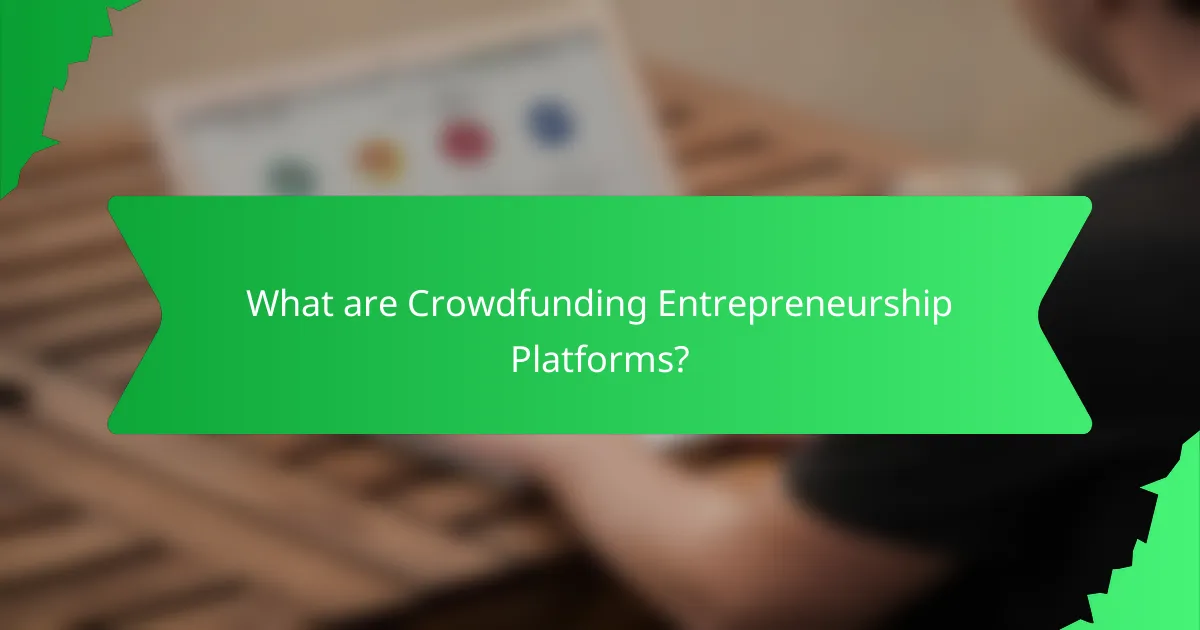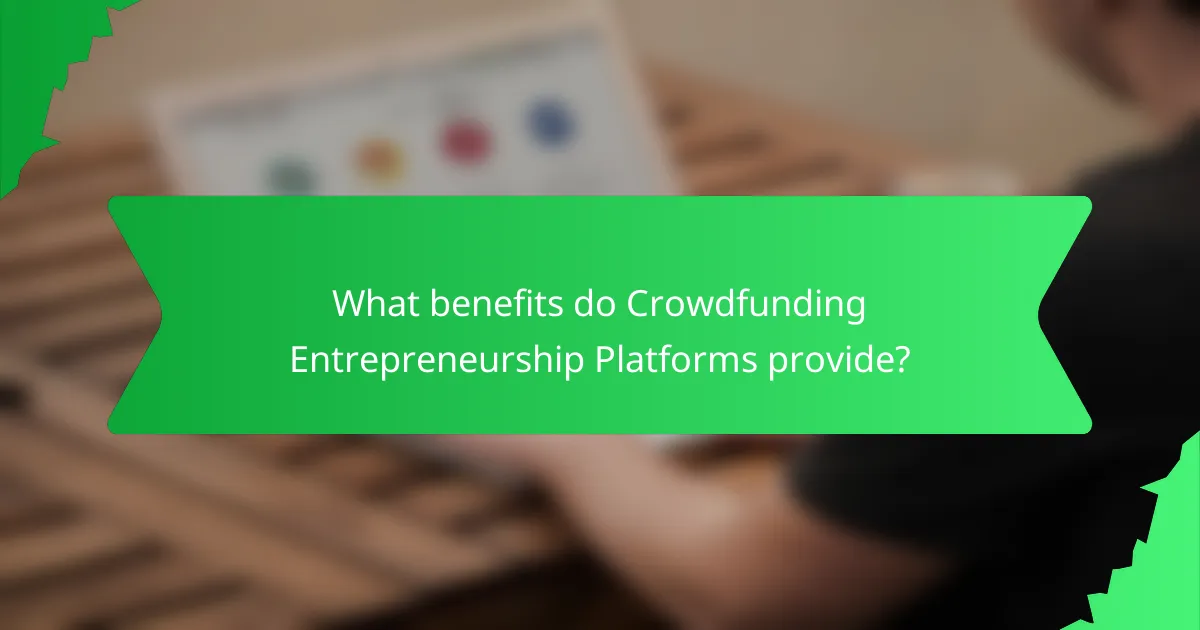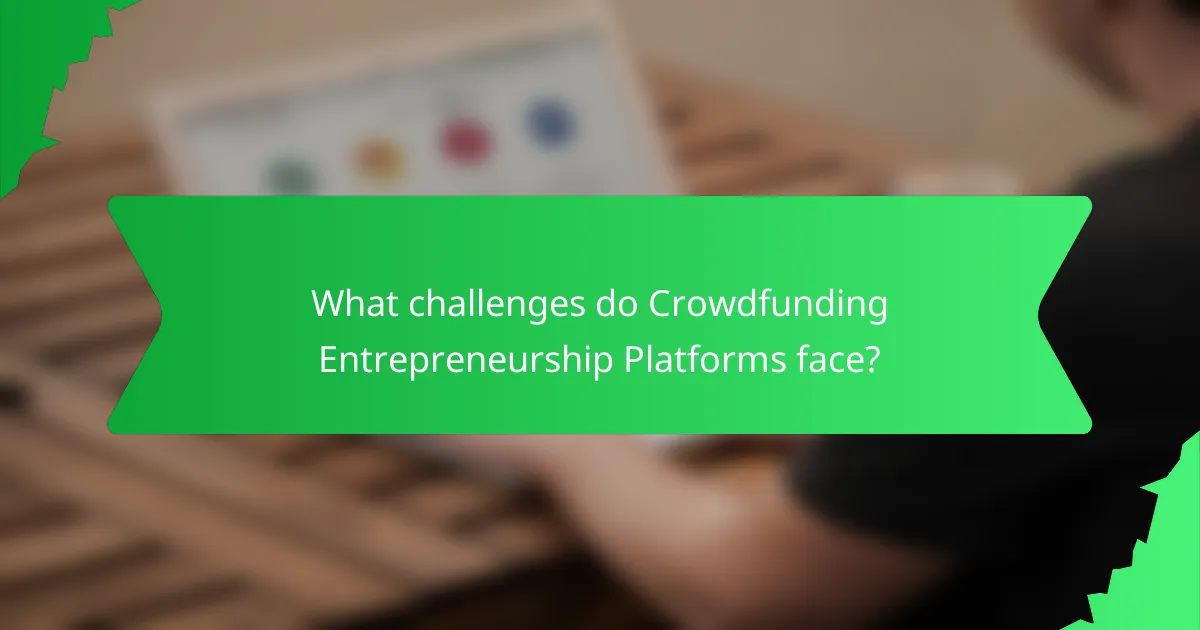Crowdfunding entrepreneurship platforms are digital services that enable startups and small businesses to raise funds by connecting them with individual investors. These platforms allow entrepreneurs to showcase their projects, set funding goals, and offer various incentives to backers, such as rewards or equity. Key benefits include democratized access to capital, lower fees compared to traditional financing, and community engagement. However, these platforms also face challenges, including regulatory compliance, trust issues, and competition. The article will explore the essential features and advantages of crowdfunding platforms, as well as the obstacles they encounter in the fundraising landscape.

What are Crowdfunding Entrepreneurship Platforms?
Crowdfunding entrepreneurship platforms are online services that facilitate fundraising for new business ventures. These platforms connect entrepreneurs seeking capital with individuals willing to invest small amounts of money. They typically allow project creators to present their ideas and set funding goals. Backers can contribute in exchange for rewards, equity, or future products. Popular crowdfunding platforms include Kickstarter and Indiegogo. These platforms have raised billions in funding for various projects. They democratize access to capital, enabling startups to launch without traditional financing methods. Crowdfunding platforms also foster community engagement and support for innovative ideas.
How do Crowdfunding Entrepreneurship Platforms operate?
Crowdfunding entrepreneurship platforms operate by connecting entrepreneurs with potential investors. These platforms allow entrepreneurs to present their business ideas to a large audience. Interested individuals can then contribute funds in exchange for rewards, equity, or other incentives. The process typically begins with an entrepreneur creating a campaign on the platform. This campaign includes a description of the project, funding goals, and timelines.
Once the campaign is live, it is promoted to attract backers. Successful campaigns often utilize social media and marketing strategies to increase visibility. If the funding goal is met within the specified timeframe, the entrepreneur receives the collected funds. If the goal is not met, funds may be returned to the backers, depending on the platform’s policy.
Platforms like Kickstarter and Indiegogo exemplify this model, enabling various projects across industries. According to research by the Cambridge Centre for Alternative Finance, crowdfunding raised over $34 billion globally in 2020. This demonstrates the growing significance of crowdfunding in supporting entrepreneurship.
What types of crowdfunding models are utilized?
The types of crowdfunding models utilized include donation-based, reward-based, equity-based, and debt-based crowdfunding. Donation-based crowdfunding allows backers to contribute without expecting anything in return. Reward-based crowdfunding offers backers a tangible reward or product for their support. Equity-based crowdfunding enables investors to receive shares in the company in exchange for their funds. Debt-based crowdfunding involves lending money to a business with the expectation of repayment with interest. Each model serves different purposes and appeals to various types of projects and investors.
What roles do entrepreneurs and backers play in these platforms?
Entrepreneurs create projects and seek funding on crowdfunding platforms. They present their ideas to attract backers. Entrepreneurs are responsible for developing a compelling pitch. They outline project goals, timelines, and budgets to gain interest.
Backers provide financial support to entrepreneurs in exchange for rewards or equity. They assess project viability and potential returns. Backers play a crucial role in validating business ideas. Their contributions help entrepreneurs launch and scale their projects.
The interaction between entrepreneurs and backers fosters innovation. This collaborative dynamic drives the success of crowdfunding platforms.
What key features define Crowdfunding Entrepreneurship Platforms?
Crowdfunding entrepreneurship platforms are defined by several key features. These platforms facilitate fundraising through collective contributions from a large number of individuals. They offer various funding models, including rewards-based, equity-based, and donation-based crowdfunding. User-friendly interfaces allow entrepreneurs to create campaigns easily. Social sharing tools enable users to promote their projects across different networks. Transparency features provide backers with updates on project progress and funding usage. Payment processing systems ensure secure transactions between funders and project creators. Analytics tools help entrepreneurs track campaign performance and backer engagement. These features collectively enhance the crowdfunding experience and increase the likelihood of project success.
How does user interface design impact user experience on these platforms?
User interface design significantly impacts user experience on crowdfunding entrepreneurship platforms. A well-designed interface enhances usability, making it easier for users to navigate the platform. Clear visual hierarchy guides users through essential features, improving engagement. Intuitive layouts reduce cognitive load, allowing users to focus on their projects. Consistent design elements foster familiarity, increasing user confidence. Research shows that 94% of first impressions are design-related, highlighting its importance. Effective user interface design can lead to higher user satisfaction and increased funding success rates.
What payment processing options are commonly available?
Common payment processing options include credit and debit cards, digital wallets, bank transfers, and payment gateways. Credit and debit cards are widely accepted for online transactions. Digital wallets like PayPal and Stripe facilitate easy payments. Bank transfers offer direct transaction methods for larger amounts. Payment gateways provide secure processing for various payment types. These options enhance user experience and increase funding potential on crowdfunding platforms.

What benefits do Crowdfunding Entrepreneurship Platforms provide?
Crowdfunding entrepreneurship platforms provide access to capital for startups and small businesses. They enable entrepreneurs to raise funds from a large pool of investors. This model democratizes funding, allowing diverse projects to gain financial support. It also fosters community engagement and brand loyalty among backers. Platforms typically charge lower fees compared to traditional financing methods. Additionally, they allow entrepreneurs to validate their ideas through market interest before launching. According to a study by the University of Cambridge, crowdfunding can increase the likelihood of business survival by up to 50%.
How do these platforms facilitate access to capital?
Crowdfunding platforms facilitate access to capital by connecting entrepreneurs with a large pool of potential investors. These platforms allow individuals to present their business ideas to the public. Investors can contribute small amounts of money, collectively funding projects that may not secure traditional financing.
According to a report by the Cambridge Centre for Alternative Finance, global crowdfunding grew to over $13 billion in 2018. This growth indicates the increasing popularity and effectiveness of these platforms in raising capital.
Additionally, platforms often provide marketing and promotional tools to help entrepreneurs reach a wider audience. They also enable direct communication between entrepreneurs and investors, fostering trust and engagement. As a result, entrepreneurs can secure funding more efficiently than through conventional methods.
What advantages do entrepreneurs gain from using crowdfunding?
Entrepreneurs gain several advantages from using crowdfunding. First, it provides access to capital without traditional bank loans. This method allows them to raise funds from a large number of people. Additionally, crowdfunding helps validate business ideas. Entrepreneurs can gauge market interest before fully committing resources. It also fosters community engagement and support. Backers often become loyal customers and advocates. Furthermore, crowdfunding platforms offer marketing exposure. Successful campaigns can attract media attention, enhancing visibility. Lastly, it allows for creative freedom. Entrepreneurs can retain equity while funding their projects.
How do backers benefit from supporting crowdfunding campaigns?
Backers benefit from supporting crowdfunding campaigns by gaining access to unique products and experiences. They often receive rewards or perks based on their contribution levels. These rewards can include early access to products, exclusive merchandise, or personalized experiences. Backers also support innovation and creativity, helping bring new ideas to market. This support fosters a sense of community and connection with creators. Additionally, backers can influence project outcomes through their feedback and engagement. Statistics show that successful campaigns often rely on backer support to reach funding goals. Overall, backers play a crucial role in the crowdfunding ecosystem while enjoying tangible benefits.
What role does community engagement play in crowdfunding success?
Community engagement is crucial for crowdfunding success. It helps build trust and credibility among potential backers. Engaged communities are more likely to share campaigns within their networks. This sharing increases visibility and attracts more funding. Research shows that campaigns with active community involvement raise 50% more funds on average. Engaged supporters often become repeat backers in future projects. Additionally, community feedback can refine project ideas and enhance appeal. Overall, strong community engagement significantly boosts the likelihood of crowdfunding success.
How can entrepreneurs leverage social media for their campaigns?
Entrepreneurs can leverage social media for their campaigns by utilizing targeted advertising and engaging content. Targeted ads allow entrepreneurs to reach specific demographics effectively. Platforms like Facebook and Instagram offer tools to customize audience parameters. Engaging content, such as videos and stories, can capture attention and promote brand awareness. According to a HubSpot report, 54% of consumers want to see more video content from brands they support. Furthermore, social media facilitates direct interaction with potential customers. This interaction can build trust and foster community. By analyzing engagement metrics, entrepreneurs can refine their strategies for better results.
What strategies enhance backer participation and loyalty?
Engaging backers through effective communication enhances participation and loyalty. Regular updates about project progress keep backers informed. Personalizing interactions fosters a sense of connection. Offering exclusive rewards creates added value for backers. Building a community around the project encourages ongoing support. Transparency in financials builds trust with backers. Recognizing and celebrating backer contributions strengthens relationships. Research indicates that projects with strong backer engagement often exceed funding goals.

What challenges do Crowdfunding Entrepreneurship Platforms face?
Crowdfunding entrepreneurship platforms face several challenges. One significant challenge is regulatory compliance. Many platforms must navigate complex legal frameworks that vary by region. This can lead to increased operational costs and delays in launching campaigns. Another challenge is trust and credibility. Users may hesitate to invest without assurance of project legitimacy. Additionally, competition among platforms is fierce. This can dilute market share and increase customer acquisition costs. Platforms also struggle with fraud risk. Instances of scams can damage reputation and user confidence. Lastly, maintaining user engagement is critical. Platforms need to continually innovate to keep users active and interested.
How do regulatory issues affect crowdfunding platforms?
Regulatory issues significantly impact crowdfunding platforms by dictating their operational framework. These regulations determine how funds can be raised and who can participate. For example, the SEC’s Regulation Crowdfunding in the United States allows businesses to raise up to $5 million from investors. Compliance with these regulations is mandatory for platforms to operate legally. Non-compliance can lead to penalties or shutdowns. Regulations also affect investor protections, ensuring that backers are informed about risks. Additionally, they influence the types of projects that can be funded. Platforms must navigate these regulatory landscapes to maintain credibility and trust. Ultimately, regulatory issues shape the viability and growth of crowdfunding platforms.
What are common risks associated with crowdfunding for entrepreneurs?
Common risks associated with crowdfunding for entrepreneurs include lack of funding, failure to meet funding goals, and potential legal issues. Entrepreneurs may struggle to attract sufficient backers, leading to inadequate financial support. If funding goals are not met, entrepreneurs often receive no funds at all. Additionally, there can be complications with intellectual property rights, as ideas may be exposed to the public. There is also the risk of negative public perception if the project fails. Entrepreneurs may face competition from similar campaigns, impacting their visibility. Furthermore, managing backer expectations can be challenging, especially if timelines are not met. Lastly, entrepreneurs may encounter platform fees, which can reduce the total funds raised.
What best practices should entrepreneurs follow when using crowdfunding platforms?
Entrepreneurs should create a compelling campaign to succeed on crowdfunding platforms. A clear and engaging project description attracts potential backers. High-quality visuals, including images and videos, enhance the campaign’s appeal. Setting a realistic funding goal is crucial; it should reflect the project’s needs without discouraging support. Entrepreneurs must communicate regularly with backers to build trust and maintain interest. Offering attractive rewards can incentivize contributions and encourage sharing. Marketing the campaign through social media and email can significantly increase visibility. Research shows that campaigns with strong promotional strategies raise 50% more than those without.
How can effective marketing strategies improve campaign outcomes?
Effective marketing strategies can significantly enhance campaign outcomes by increasing visibility and engagement. Targeted marketing ensures that the right audience sees the campaign. This leads to higher conversion rates and more funds raised. Utilizing social media platforms can amplify reach and foster community support. Research shows that campaigns with strong marketing strategies can raise up to 200% more than those without. Additionally, clear messaging resonates better with potential backers, driving interest and investment. Successful campaigns often employ data analytics to refine their approach, tailoring strategies based on audience behavior.
What tips can help in setting realistic funding goals?
Set realistic funding goals by assessing your project’s budget and timeline. Determine how much money you need to reach your objectives. Break down the total amount into smaller, manageable milestones. Research similar projects to understand their funding levels and success rates. Consider your audience’s willingness to contribute based on previous campaigns. Set a time frame for your funding goal that aligns with your project’s launch. Regularly review and adjust your goals based on feedback and progress. Establish a clear communication strategy to keep backers informed and engaged throughout the process.
Crowdfunding entrepreneurship platforms are online services that facilitate fundraising for new business ventures by connecting entrepreneurs with potential investors. This article outlines the key features of these platforms, including various funding models such as donation-based, reward-based, equity-based, and debt-based crowdfunding. It also discusses the roles of entrepreneurs and backers, the benefits of using these platforms, and the impact of user interface design on user experience. Additionally, it addresses the challenges faced by crowdfunding platforms, common risks for entrepreneurs, and best practices for successful campaigns.
